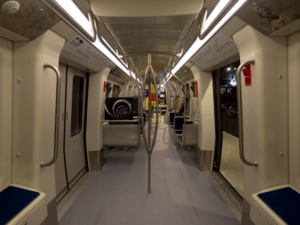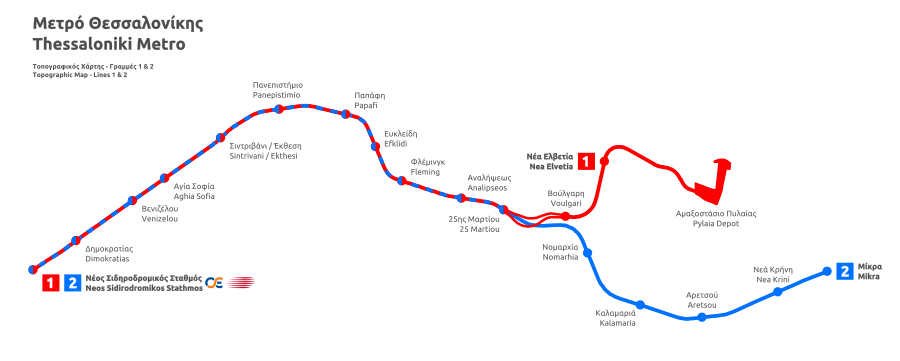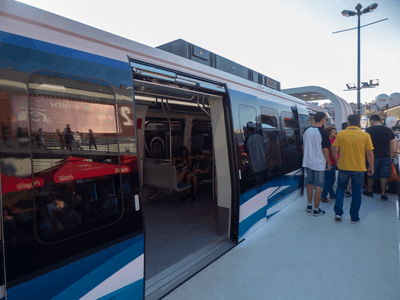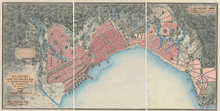Thessaloniki Metro
 Thessaloniki Metro AnsaldoBreda Driverless Metro unit on display at the Thessaloniki International Fair | |||
| Overview | |||
|---|---|---|---|
| Native name | Μετρό Θεσσαλονίκης | ||
| Owner | Attiko Metro | ||
| Locale | Thessaloniki, Greece | ||
| Transit type | Rapid transit, Light metro | ||
| Number of lines | 2[1][2] | ||
| Number of stations | 34 (18 under construction, 16 planned)[3] | ||
| Daily ridership | 320,000 (projected)[4] | ||
| Website | Official Attiko Metro page | ||
| Operation | |||
| Operation will start | November 2020[5][6] | ||
| Character | Underground subway | ||
| Number of vehicles | 33 AnsaldoBreda Driverless Metro[7] | ||
| Headway | 90 seconds[7] | ||
| Technical | |||
| System length |
14.28 km (8.87 mi) in 2021[8][9] 31.6 km (19.6 mi) when finished[1][8][9][10] | ||
| Track gauge | 1,435 mm (4 ft 8 1⁄2 in) standard gauge | ||
| Electrification | 750 V DC third rail[7] | ||
| Top speed | 90 km/h (56 mph)[7] | ||
| |||
The Thessaloniki Metro (Greek: Μετρό Θεσσαλονίκης, ![]()
Proposed during the 1910s and first seriously planned in the 1980s, construction of the main line began in 2006 and on the Kalamaria extension in 2013. Although the initial proposal included three extensions to the main line, the latest Attiko Metro proposal seeks to combine the two westward extensions as a loop; the system will be made up of the main line and the Kalamaria and Evosmos extensions. The system under construction has 18 stations and 14.4 km (8.9 mi) of tunnels. A request for tender will be issued for the western loop in the autumn of 2018.
After years of delays, due mainly to archaeological discoveries in the city centre during construction and in part to the Greek financial crisis, most of the main line is scheduled to open in November 2020; the rest of the main line and the Kalamaria extension will be finished by mid-2021. According to Attiko Metro, the completed metro will be "not only better than the Athens Metro, but the most modern metro in Europe".[8]
1910s and 1980s proposals
Ernest Hébrard was the first person to suggest an underground metropolitan rail system for Thessaloniki during the city's redesign in the early 1910s.[12] Hébrard and Thomas Hayton Mawson headed a commission appointed by the government of Eleftherios Venizelos to redesign Thessaloniki after the Great Fire of 1917, which had devastated the city centre. They proposed an underground rail line to allow easy access from the city centre to the planned outskirts of the city in the east. Although Thessaloniki has grown considerably since Hébrard's original design, Line 1 is almost identical to his plan and runs from his proposed New Railway Station to the suburb of Nea Elvetia.[13][14] The project never materialised. A circular metro line was proposed in 1968, extending to the airport and crossing the Thermaic Gulf in a tunnel.[11]
The idea of a metro was revived during the 1980s. In 1988, under Mayor Sotiris Kouvelas, the city published studies for its Thessaloniki Metro development plan and construction of the project's first phase.[15] The line was almost identical to the modern line, with 14 stations between the New Railway Station and Nea Elvetia. The plan had one additional station, Patrikiou, between 25 Martiou and Voulgari and had alternative names for three stations. Dimokratias is shown as Vardari, an alternative name for the public square served by the station; Venizelou is listed as Alkazar (Hamza Bey Mosque, on the corner of Egnatia and Venizelou Streets), and Efklidi is shown as Archaeological Museum Street.[15] The network would be within the city limits, excluding Kalamaria and a large portion of Thessaloniki's metropolitan area. Of the 7.77 km (4.83 mi) of track proposed, 6.26 km (3.89 mi) would be underground and 1.51 km (0.94 mi) above ground.[15]

In 1989, construction began on the first 650 metres (2,130 ft) of tunnel along Egnatia street between the Thessaloniki International Fair grounds and Aristotle University of Thessaloniki (the present Panepistimio station).[15] Construction was carried out with the cut-and-cover method instead of a tunnel boring machine. The proposed metro was only 4.5 metres (15 ft) beneath ground level at 25 Martiou and dropped to about 10 metres (33 ft) towards the New Railway Station, creating archaeological problems similar to those encountered during construction of the current system. Although construction was scheduled to end in 1995, the project stalled and became known as "the hole of Kouvelas" (Greek: η τρύπα του Κούβελα).[15] It ultimately failed, due to a series of failed contract competitions and appeals of awarded contracts. Another obstacle was lack of interest by Greece's central government. Thessaloniki attempted to fund the project on its own, saying that European Union member states were prepared to cover 50 percent of the project costs and provide favourable loans for the remainder, but without central-government involvement the plan did not go forward.[15] One reason for the lack of central-government support was Greece's political polarisation during the 1980s; Kouvelas represented the centre-right New Democracy party when the country was governed by the Panhellenic Socialist Movement.[13] Plans for a Thessaloniki metro were abandoned until the 2000s.
Present system

In 2018, Attiko Metro was overseeing the construction of a two-line, twin-tunnel system composed of Line 1 (the base project) and Line 2 (the Kalamaria Extension). Although Line 1 has been delayed, Line 2's construction is proceeding on schedule.[13] Construction of tunnels for both lines was finished in 2018, and track-laying began in August of that year.[16] The section between Sintrivani/Ekthesi and Nea Elvetia is scheduled to open in 2020, with the sections from N. Sid. Stathmos to Sintrivani/Ekthesi and 25 Martiou to Mikra opening in 2021. Both lines are designed to serve a minimum of 18,000 passengers per hour in each direction, with a 90-second headway.[7][17] The completed metro will reduce Thessaloniki's greenhouse gas emissions by an estimated 5,000 tons a year, and reduce travel time by up to 66 percent.[18]


Line 1 (Base Project)

What is known as the Base Project (Greek: Βασικό Έργο) began in 2003, when Attiko Metro and the Greek government agreed to cooperate on a public works project.[8] Government support was instrumental, since lack of government support for the 1988 proposal was the primary reason it had failed. The project issued a request for tender in 2004–2005, and the successful Greco-Italian consortium (which included AnsaldoBreda) began construction in late June 2006.[8] An alternate consortium, Macedonian Metro (Greek: Μακεδονικό Μετρό), was barred by the European Court of Justice from participating in the tender because it changed its composition after the tender proceedings began (violating EU law).[19] The project was budgeted at €1.05 billion ($1.18 billion), with 25 percent funding from the Greek government and 75 percent funded by loans from the European Investment Bank and the European Regional Development Fund.[20] Line 1 runs within the city of Thessaloniki, the core of its urban area.
It has two parallel single-track tunnels on a 9.5 km (5.9 mi) route between Neos Sidirodromikos Stathmos (N. Sid. Stathmos, at the city's New Railway Station) and Nea Elvetia, with Pylaia depot further southeast. Although construction began in 2006, major archaeological finds in the city centre delayed the project considerably. Disputes between Attiko Metro, the city council, and archaeologists reached Greece's Council of State, the country's highest administrative court, in 2015.[13] The original schedule had Line 1 operational by 2012.[13] Attiko Metro redesigned several stations in a solution which became known as "antiquities and metro" (Greek: και αρχαία και μετρό).[21] Some finds discovered on the line, primarily at Venizelou, will make up the world's first open archaeological site in a metro station.[21]
Construction of the tunnels was completed on 31 July 2018, 12 years and one month after breaking ground.[22] That day, the architectural work on Line 1 was reported as 80 percent finished.[22] In August 2018, tracks and electronic signalling equipment began installation.[16] The line will enter service in sections between 2020 and 2021; the section between Sintrivani/Ekthesi and Nea Elvetia is scheduled to open in 2020, and the section between N. Sid. Stathmos and Sintrivani/Ekthesi will open in 2021 due to the archaeological delays.[2]
Line 2 (Kalamaria Extension)

The Kalamaria Extension (Greek: Επέκταση Καλαμαριάς) extends the metro system to Kalamaria, the second-largest municipality in the Thessaloniki urban area and the 18th-most-populous in Greece. Similar in construction to Line 1, it has two parallel single-track tunnels on a 4.78 km (2.97 mi) route between 25 Martiou and Mikra and adds five stations to the network.[8] Construction on the project began in 2013, with an budget of €518 million ($583.99 million).[20][8] By 31 July 2018, the extension was 60 percent completed.[22] Although construction began seven years after Line 1, it is also expected to fully enter service in 2021.[2] This is due to the lack of major archaeological works, enabling the project to proceed without delays.[13]
After confusion about the extension's place in the system, Attiko Metro clarified in August 2018 that it would be a separate line running between N. Sid. Stathmos and Mikra without the need to change trains at 25 Martiou.[2] A September 2018 Attiko Metro press release referred to "the two lines under construction".[10]
Future extensions
Thessaloniki Metro | ||||||||||||||||||||||||||||||||||||||||||||||||||||||||||||||||||||||||||||||||||||||||||||||||||||||||||||||||||||||||||||||||||||||||||||||||||||||||||||||||||||||||||||||||||||||||||||||||||||||||||||||||||||||||||||||||||||||||||||||
|---|---|---|---|---|---|---|---|---|---|---|---|---|---|---|---|---|---|---|---|---|---|---|---|---|---|---|---|---|---|---|---|---|---|---|---|---|---|---|---|---|---|---|---|---|---|---|---|---|---|---|---|---|---|---|---|---|---|---|---|---|---|---|---|---|---|---|---|---|---|---|---|---|---|---|---|---|---|---|---|---|---|---|---|---|---|---|---|---|---|---|---|---|---|---|---|---|---|---|---|---|---|---|---|---|---|---|---|---|---|---|---|---|---|---|---|---|---|---|---|---|---|---|---|---|---|---|---|---|---|---|---|---|---|---|---|---|---|---|---|---|---|---|---|---|---|---|---|---|---|---|---|---|---|---|---|---|---|---|---|---|---|---|---|---|---|---|---|---|---|---|---|---|---|---|---|---|---|---|---|---|---|---|---|---|---|---|---|---|---|---|---|---|---|---|---|---|---|---|---|---|---|---|---|---|---|---|---|---|---|---|---|---|---|---|---|---|---|---|---|---|---|---|---|---|---|---|---|---|---|---|---|---|---|---|---|---|---|---|
| ||||||||||||||||||||||||||||||||||||||||||||||||||||||||||||||||||||||||||||||||||||||||||||||||||||||||||||||||||||||||||||||||||||||||||||||||||||||||||||||||||||||||||||||||||||||||||||||||||||||||||||||||||||||||||||||||||||||||||||||
(Development Plan) | ||||||||||||||||||||||||||||||||||||||||||||||||||||||||||||||||||||||||||||||||||||||||||||||||||||||||||||||||||||||||||||||||||||||||||||||||||||||||||||||||||||||||||||||||||||||||||||||||||||||||||||||||||||||||||||||||||||||||||||||
| ||||||||||||||||||||||||||||||||||||||||||||||||||||||||||||||||||||||||||||||||||||||||||||||||||||||||||||||||||||||||||||||||||||||||||||||||||||||||||||||||||||||||||||||||||||||||||||||||||||||||||||||||||||||||||||||||||||||||||||||
The system is planned to be extended further, with a four-station eastern extension to Line 2 (towards Macedonia International Airport) and an eight-station loop in the west.[23] The latter is a priority for Attiko Metro to connect the city's western working class suburbs with the city centre, since the airport will be serviced by a 10-minute shuttle-bus trip to Mikra (the eastern terminus of Line 2).[2] The two western extensions were originally planned as separate lines, but were merged into a single circular line in 2018.[1] Work on the western extensions will begin the tendering process in autumn 2018.[10]
According to Attiko Metro, the double-track airport extension will be a mixture of underground, grade-level, and elevated railway elements.[10] It may be extended south to Chalkidiki.[10] The western loop will be extended with three branches, adding four stations.[3]
Stations, depot and rolling stock
All 18 stations currently under construction were designed with platform screen doors for maximum protection and driverless trains.[7] Eighteen AnsaldoBreda Driverless Metro units will be in service on Line 1, and 15 on Line 2.[7] The articulated, four-car trains will be 50 metres (160 ft) long.[24] They will have seating for 96 passengers and standing room for 370 more.[24] A carriage was on display at the September 2018 Thessaloniki International Fair before trial runs in 2019.[25] The depot, which is also the metro's command centre, covers an area of 50,000 m2 (540,000 sq ft) and serves Lines 1 and 2.[8] The system's level of automation has prompted Attiko Metro to call it "the most modern metro in Europe".[8]
- Thessaloniki Metro stations will be equipped with platform screen doors on island platforms, similar to Copenhagen's Forum Station (pictured).
 Thessaloniki Metro AnsaldoBreda Driverless Metro carriage at the September 2018 Thessaloniki International Fair
Thessaloniki Metro AnsaldoBreda Driverless Metro carriage at the September 2018 Thessaloniki International Fair
Fares and park and ride
As part of the initial design, 3,700 park and ride parking spaces were created. These were at the two terminals of Line 1 – N. Sid. Stathmos (1,050) and Nea Elvetia (650 spaces) – and at Panepistimio (2,000), the system's halfway point serving Greece's largest university.[8] Additional parking will be created at Mikra, the terminus of Line 2.[26]
Attiko Metro conducted a 2005 survey to determine Thessaloniki residents' preferred fare for the metro compared to the standard price of a Thessaloniki Urban Transport Organization (OASTH) bus ticket (€0.50 at the time). Of the 400 respondents, 47.6 percent said that they were willing to pay the same price and 48.1 percent said they would pay more. Of the latter, 19.9 percent said that they would pay €0.60; 19.6 percent would pay €0.70, and 8.6 percent would be willing to pay €1.00 (double the cost of a bus ticket).[27] The remaining 4.7 percent responded with another fare. A standard 2018 single-trip OASTH bus ticket is €1.00, or €0.50 with a discount.[28]
Archaeology
.svg.png)
A large number of important archaeological finds, primarily Roman and early Christian and Byzantine, have been discovered during the metro's construction. The project triggered the largest archaeological dig in northern Greek history, covering a 20-square-kilometre (7.7 sq mi) area.[10] Between the New Railway Station and Sintrivani/Ekthesi, the metro runs below Egnatia Street (one of Thessaloniki's main arteries). Egnatia follows the Roman Via Egnatia, which connected Rome and Constantinople as one of the two most important roads in the Roman and Byzantine empires.[29] The portion of the Via Egnatia which passed through Thessaloniki was the city's Decumanus Maximus (main road), and runs below present-day Egnatia Street at 5.4 metres (18 ft) below ground level.[13]
Although the location of the Via Egnatia in Thessaloniki was known when the metro line was planned, it was uncertain what else was buried nearby. The metro was planned to run at 8 metres (26 ft) below ground, leaving only 2.6 metres (8.5 ft) between it and the ancient road. The discovery of a Byzantine road at Venizelou station was a major archaeological find: 75 metres (246 ft) of the marble-paved and column-lined road was unearthed, with shops, other buildings, and plumbing which one scholar called "the Byzantine Pompeii".[30] A crossroads, marked with a tetrapylon, was found at Venizelou where the Decumanus Maximus crossed a cardo (a north-south road).[31] An additional 22 metres (72 ft) of the same road was discovered at the Aghia Sofia station.[31] Issues concerning archaeological finds and the display of artefacts in the metro system are more complex than similar issues surrounding the construction of the New Acropolis Museum.[31]
Other important discoveries included a headless statue of Aphrodite, fourth-century-AD mosaics, a golden wreath, a bath complex, urban villas, and 50,000 coins.[32][33][34][35] Artefacts from the 1917 fire were also found.[36]
The discovery sparked controversy in Thessaloniki; Attiko Metro wanted to remove the antiquities and re-assemble them elsewhere, and the city's archaeological services wanted the company to alter the depth of the line and the station entrances. The city council sided with the archaeological services in 2015, three years after the metro was originally planned to begin service.[13] Mayor Yiannis Boutaris took the case to the Council of State, Greece's highest administrative court.[37] Attiko Metro redesigned the line, sinking the tunnels to depths from 14 to 31 metres (46 to 102 ft) and providing for mini-museums in the stations similar to the Syntagma metro station in Athens (which houses the Syntagma Metro Station Archaeological Collection).[38] The Venizelou station will contain an open archaeological site, the world's first metro station to do so.[10][21]
The archaeological excavations are currently budgeted at €132 million ($149 million),[10] compared with the original archaeological budget of €15 million ($17 million),[13] and employ 300 archaeologists.[38] Over 300,000 artefacts have been unearthed to date.[10] The archaeological work is being carried out by the Ministry of Culture and Sports' Ephorate of Prehistoric and Classical Antiquities and the Ephorate of Byzantine Antiquities.
| Station | Major find(s) | Importance |
|---|---|---|
| N. Sid. Stathmos | Mid | |
| Dimokratias | Ancient and early Christian cemetery and church, Ottoman inns and warehouses | High |
| Venizelou | Roman-Byzantine Decumanus Maximus and cardo[31] | High |
| Aghia Sofia | Roman-Byzantine Decumanus Maximus, commercial centre[13] | High |
| Sintrivani/Ekthesi | Byzantine basilica | Mid |
| Panepistimio | Mid | |
| Fleming | Roman cemetery and small settlement | Low |
| Pylaia depot | Settlement dated to the 4th–3rd century BC, tufa sarcophagus | Low |
In popular culture
Construction delays have made the Thessaloniki Metro the butt of a number of jokes in Greece.[39][40][41][42] News satire websites such as To Koulouri have satirised the metro on numerous occasions with stories such as "Thessaloniki Metro will operate on a 24-hour basis during the Christmas rush"[43] and "Thessaloniki Metro enters its 763rd day of strike",[44] and it has been cited in satirical lyrics by the Greek rapper Tus.[45] Greek prime minister Alexis Tsipras joked about the delays at the 2018 Thessaloniki International Fair: "What's happening with the metro, guys? Will it get built here?"[46]
Gallery
- Pre-fabricated concrete tunnel-wall pieces
- Work on the New Railway Station
- Construction seen from a tunnel interior
- Tunnel under construction
See also
References
- 1 2 3 Attiko Metro S.A. "Extensions". www.ametro.gr. Archived from the original on 10 August 2018. Retrieved 10 August 2018.
To this end, ATTIKO METRO S.A. is designing and suggesting a solution combining both individual extensions into a circular line of a unified form.
- 1 2 3 4 5 "Η Συνέντευξη τoυ Γιάννη Μυλόπουλου για το Μετρό Θεσσαλονίκης" [Giannis Mylopoulos' interview about the Thessaloniki Metro]. www.ypodomes.gr. Archived from the original on 12 September 2018. Retrieved 12 August 2018.
- 1 2 Attiko Metro S.A. "Thessaloniki Metro Lines Development Plan" (PDF). www.ametro.gr. Archived from the original (PDF) on 19 September 2018. Retrieved 18 September 2018.
- ↑ "Μυλόπουλος: Το 2020 θα κυκλοφορούν καθημερινά 320.000 επιβάτες με το μετρό της Θεσσαλονίκης" [Mylopoulos: In 2020 320,000 people will travel on the Thessaloniki metro system]. www.movenews.gr. Archived from the original on 12 August 2018. Retrieved 12 August 2018.
- ↑ "Μετρό Θεσσαλονίκης: Χαμόγελα στα εργοτάξια μετά από χρόνια" [Thessaloniki Metro: Smiles at the construction sites after years]. www.iefimerida.gr (in Greek). 2 March 2016. Archived from the original on 8 August 2018. Retrieved 13 August 2018.
- ↑ "Θεσσαλονίκη: Νοέμβριο του 2020 παραδίδεται η 1η γραμμή μετρό Νέα Ελβετία-Συντριβάνι" [Thessaloniki: The 1st line from Nea Elvetia to Sintrivani will be opened in 2020]. www.iefimerida.gr (in Greek). 20 March 2018. Archived from the original on 7 August 2018. Retrieved 13 August 2018.
- 1 2 3 4 5 6 7 Technical Description (PDF), Attiko Metro S.A., 1 December 2014, archived from the original (PDF) on 11 September 2018
- 1 2 3 4 5 6 7 8 9 10 Attiko Metro S.A. "Ιστορικό" [History]. www.ametro.gr (in Greek). Archived from the original on 13 August 2018. Retrieved 17 August 2018.
- 1 2 Attiko Metro S.A. "Extension to Kalamaria". www.ametro.gr. Archived from the original on 19 September 2018. Retrieved 29 August 2018.
- 1 2 3 4 5 6 7 8 9 "ΑΤΤΙΚΟ ΜΕΤΡΟ: «Το Μέτρο στη πόλη μας» με το πρώτο του βαγόνι. Συμμετοχή της Αττικό Μετρό Α.Ε. στην 83η Δ.Ε.Θ." [Attiko Metro: "The Metro in our city" with the first carriage. The participation of Attiko Metro S.A. at the 83rd Thessaloniki International Fair]. www.ametro.gr (in Greek). Archived from the original on 9 September 2018. Retrieved 8 September 2018.
- 1 2 Naniopoulos, Aristotelis; Nalmpantis, Dimitrios. Συστήµατα σταθερής τροχιάς στην πόλη της Θεσσαλονίκης. Ιστορική αναδροµή (1889-1968) [Fixed-track systems in Thessaloniki. Historical Retrospective (1889-1968)]. www.docplayer.gr (in Greek). Aristotle University of Thessaloniki. Archived from the original on 14 September 2018. Retrieved 14 August 2018.
- ↑ Gerolympou, Alexandra (1995). Η Ανοικοδόμηση της Θεσσαλονίκης Μετά την Πυρκαγιά του 1917 [The Rebuilding of Thessaloniki after the Great Fire of 1917] (in Greek) (Second ed.). Aristotle University of Thessaloniki University Press.
- 1 2 3 4 5 6 7 8 9 10 Skai TV. "Ιστορίες: Μετρό Θεσσαλονίκης" [Stories: Thessaloniki Metro]. www.skai.gr (in Greek). Archived from the original on 13 August 2018. Retrieved 13 August 2018.
- ↑ "Πώς το σχέδιο Εμπράρ άλλαξε την εικόνα της Θεσσαλονίκης" [How the Hébrard plan changed the image of Thessaloniki]. www.voria.gr (in Greek). Archived from the original on 13 August 2018. Retrieved 10 August 2018.
- 1 2 3 4 5 6 7 "Κι όμως! Το ΜΕΤΡΟ Θεσσαλονίκης είναι έτοιμο (στα χαρτιά) από το 1987!" [It's true! The Thessaloniki Metro was ready (on paper) in 1987 already!]. www.karfitsa.gr (in Greek). Archived from the original on 17 August 2018. Retrieved 13 August 2018.
- 1 2 "Γ. Μυλόπουλος: Όλοι οι σταθμοί του Μετρό Θεσσαλονίκης έχουν ολοκληρωθεί κατασκευαστικά" [G. Mylopoulos: construction on all Thessaloniki Metro stations has finished] (in Greek). Archived from the original on 11 September 2018. Retrieved 10 September 2018.
- ↑ Technical Description (PDF), Attiko Metro S.A., 18 June 2018, archived from the original (PDF) on 11 September 2018
- ↑ "New metro improves quality of life in Thessaloniki". www.ec.europa.eu. European Commission. Archived from the original on 22 September 2018. Retrieved 22 September 2018.
- ↑ "«Φρένο» στη Μακεδονικό Μετρό από την Ε.Ε." [The EU has put "the brakes" on Makedoniko Metro]. www.tanea.gr (in Greek). Ta Nea. 24 January 2003. Archived from the original on 23 September 2018. Retrieved 23 September 2018.
- 1 2 Attiko Metro S.A. "Funding". www.ametro.gr. Archived from the original on 11 August 2018. Retrieved 5 June 2018.
- 1 2 3 "The first Metro network with ancient monuments". www.yougoculture.com. National and Kapodistrian University of Athens. 16 March 2018. Archived from the original on 11 September 2018. Retrieved 11 September 2018.
- 1 2 3 Attiko Metro S.A. "THESSALONIKI METRO: The Metromole activities have come to an end". www.ametro.gr. Archived from the original on 30 August 2018. Retrieved 30 August 2018.
- ↑ Attiko Metro S.A. "Thessaloniki Metro Map". www.ametro.gr. Archived from the original on 13 August 2018. Retrieved 13 August 2018.
- 1 2 "Salonicco". Hitachi Rail Italy. Archived from the original on 11 September 2018. Retrieved 11 September 2018.
- ↑ "Αυτό είναι το πρώτο βαγόνι του Μετρό Θεσσαλονίκης" [This is the first carriage of the Thessaloniki Metro] (in Greek). Archived from the original on 11 September 2018. Retrieved 10 September 2018.
- ↑ Attiko Metro S.A. "Extension to Kalamaria". www.ametro.gr. Retrieved 17 August 2018.
- ↑ Brebbia, C. A. (2008). Urban Transport XIV: Urban Transport and the Environment in the 21st Century. WIT Press. p. 6. ISBN 9781845641238.
- ↑ "Κόμιστρα" [Fares]. oasth.gr (in Greek). Thessaloniki Urban Transport Organization. Archived from the original on 23 August 2018. Retrieved 9 September 2018.
- ↑ Wang, George C. (24 June 2016). The Utilization of Slag in Civil Infrastructure Construction. Woodhead Publishing. p. 340. ISBN 9780081003978.
- ↑ Giorgos Christides (14 March 2013). "Thessaloniki metro: Ancient dilemma for modern Greece". www.bbc.co.uk. Archived from the original on 15 September 2017. Retrieved 13 August 2018.
- 1 2 3 4 Zosia, Archibald; Morgan, Catherine; Smith, David M.; Murphy-Smith, Helen; Pitt, Robert; Papadopoulou, Chryssanthi; Marchand, Fabienne; Haysom, Matthew; Livarda, Alexandra; Stewart, Daniel (2013). "Archaeology in Greece 2013–2014". The Society for the Promotion of Hellenic Studies: 9, 100. JSTOR 43187051.
- ↑ "Greece: subway construction unearths ancient Aphrodite statue and stunning mosaic floors". www.newsweek.com. Newsweek. 26 February 2018. Archived from the original on 11 September 2018. Retrieved 11 September 2018.
- ↑ "Thessaloniki subway dig unearths secrets of 'city under the city'". www.straitstimes.com. The Straits Times. 28 April 2018. Archived from the original on 11 September 2018. Retrieved 11 September 2018.
- ↑ "The Golden Wreaths of the Thessaloniki Metro Excavations". www.biblicalarchaeology.org. Biblical Archaeology Society. 29 January 2013. Archived from the original on 11 September 2018. Retrieved 11 September 2018.
- ↑ "Archaeologists unearth headless Aphrodite statue in Thessaloniki". www.diaspora.parliament.gr. Hellenic Parliament. 22 February 2018. Archived from the original on 11 September 2018. Retrieved 11 September 2018.
- ↑ "Θεσσαλονίκη: Ολα τα αρχαία που αναδύθηκαν μέσω… Μετρό" [Thessaloniki: All the antiquities that surfaced via... the metro]. www.protagon.gr (in Greek). Archived from the original on 9 September 2018. Retrieved 9 September 2018.
- ↑ "Construction of Thessaloniki Metro to resume after agreement reached". www.tovima.gr. To Vima. 29 August 2013. Archived from the original on 11 September 2018. Retrieved 11 September 2018.
- 1 2 3 Attiko Metro S.A. "Αρχαιολογικές ανασκαφές" [Archaeological excavations]. www.ametro.gr (in Greek). Archived from the original on 13 August 2018. Retrieved 13 August 2018.
- ↑ "Υπάρχουν τα μετρό…και το Μετρό Θεσσαλονίκης!" [There's metros... and then there's the Thessaloniki Metro]. www.parallaximag.gr (in Greek). 11 June 2016. Archived from the original on 12 June 2017. Retrieved 24 September 2018.
- ↑ Papadimitriou, Georgios (24 September 2016). "ΟΑΣΘ – Θεσσαλονίκη: μία σχέση χυδαίας εξάρτησης" [OASTH – Thessaloniki: a relationship of gross dependency]. www.typosthes.gr (in Greek). Archived from the original on 29 October 2016. Retrieved 24 September 2018.
- ↑ Makrogiannelis, Giannis (8 July 2016). "Ήμουν Νιός και Γέρασα: Τριάντα Χρόνια Μετρό Θεσσαλονίκης Χωρίς Μετρό στη Θεσσαλονίκη" [I was Young and now I'm Old: Thirty Years of Thessaloniki Metro without a Metro in Thessaloniki]. www.vice.gr (in Greek). Vice News. Archived from the original on 14 September 2017. Retrieved 25 September 2018.
- ↑ "Ένα χρόνο ακόμη έχουμε για να κάνουμε αστεία με το Μετρό της Θεσσαλονίκης" [We only have one more year left to make jokes about the Thessaloniki Metro]. www.luben.tv (in Greek). Luben. 30 March 2018. Archived from the original on 25 September 2018. Retrieved 25 September 2018.
- ↑ "Ως Χριστουγεννιάτικο χωριό θα λειτουργεί το Μετρό Θεσσαλονίκης για την περίοδο των εορτών". www.tokoulouri.com. To Koulouri. Archived from the original on 19 September 2018. Retrieved 24 September 2018.
- ↑ "Συνεχίζεται για 763η ημέρα η απεργία στο μετρό Θεσσαλονίκης". www.tokoulouri.com. To Koulouri. Archived from the original on 12 January 2018. Retrieved 24 September 2018.
- ↑ "Στίχοι: Tus & Marinos - Όμορφη Σαλονικιά". www.radiomelodia.gr (in Greek). 10 April 2016. Archived from the original on 17 January 2018. Retrieved 25 September 2018.
Μου ‘πε πως η αγάπη μας αντέχει / Και ότι είναι σαν το μετρό, δεν θα τελείωνε ποτέ [She told me that our love will endure / And that it's like the metro, it will never end]
- ↑ Chatzinikolaou, Nikos (8 September 2018). "Το αστείο του Τσίπρα στον Σπίρτζη για το Μετρό της Θεσσαλονίκης" [Tsipras' joke to Spirtzis about the Thessaloniki Metro]. www.real.gr. Archived from the original on 25 September 2018. Retrieved 25 September 2018.
Sources
- Archived information
- Thessaloniki Metro and the Athens Metro Extensions (Greek Ministry of Environment, Physical Planning and Public Works press release 2006-02-20)
- Conclusion of contract for the Thessaloniki metro (Greek Ministry of Environment, Physical Planning and Public Works press release 2006-04-07)
External links
| Wikimedia Commons has media related to Thessaloniki metro. |

